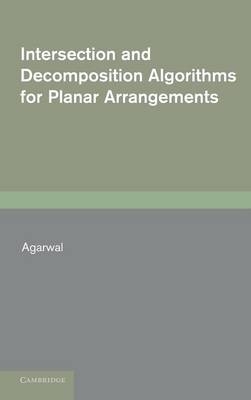
Intersection and Decomposition Algorithms for Planar Arrangements
Seiten
1991
Cambridge University Press (Verlag)
978-0-521-40446-4 (ISBN)
Cambridge University Press (Verlag)
978-0-521-40446-4 (ISBN)
Several geometric problems can be formulated in terms of the arrangements of a collection of curves in a plane, making this one of the most widely studied topics in computational geometry. This book, first published in 1991, presents a study of problems related to arrangements of lines or curves in the plane.
Several geometric problems can be formulated in terms of the arrangement of a collection of curves in a plane, which has made this one of the most widely studied topics in computational geometry. This book, first published in 1991, presents a study of various problems related to arrangements of lines, segments, or curves in the plane. The first problem is a proof of almost tight bounds on the length of (n,s)-Davenport–Schinzel sequences, a technique for obtaining optimal bounds for numerous algorithmic problems. Then the intersection problem is treated. The final problem is improving the efficiency of partitioning algorithms, particularly those used to construct spanning trees with low stabbing numbers, a very versatile tool in solving geometric problems. A number of applications are also discussed. Researchers in computational and combinatorial geometry should find much to interest them in this book.
Several geometric problems can be formulated in terms of the arrangement of a collection of curves in a plane, which has made this one of the most widely studied topics in computational geometry. This book, first published in 1991, presents a study of various problems related to arrangements of lines, segments, or curves in the plane. The first problem is a proof of almost tight bounds on the length of (n,s)-Davenport–Schinzel sequences, a technique for obtaining optimal bounds for numerous algorithmic problems. Then the intersection problem is treated. The final problem is improving the efficiency of partitioning algorithms, particularly those used to construct spanning trees with low stabbing numbers, a very versatile tool in solving geometric problems. A number of applications are also discussed. Researchers in computational and combinatorial geometry should find much to interest them in this book.
Introduction; 1. Davenport–Schinzel sequences; 2. Red-blue intersection detection algorithms; 3. Partitioning arrangements of lines; 4. Applications of the partitioning algorithm; 5. Spanning trees with low stabbing number; Bibliography; Index of symbols; Index of keywords.
| Erscheint lt. Verlag | 26.4.1991 |
|---|---|
| Verlagsort | Cambridge |
| Sprache | englisch |
| Maße | 156 x 238 mm |
| Gewicht | 556 g |
| Themenwelt | Mathematik / Informatik ► Mathematik ► Graphentheorie |
| ISBN-10 | 0-521-40446-0 / 0521404460 |
| ISBN-13 | 978-0-521-40446-4 / 9780521404464 |
| Zustand | Neuware |
| Haben Sie eine Frage zum Produkt? |
Mehr entdecken
aus dem Bereich
aus dem Bereich
Numbers and Counting, Groups, Graphs, Orders and Lattices
Buch | Softcover (2023)
De Gruyter (Verlag)
CHF 89,95
